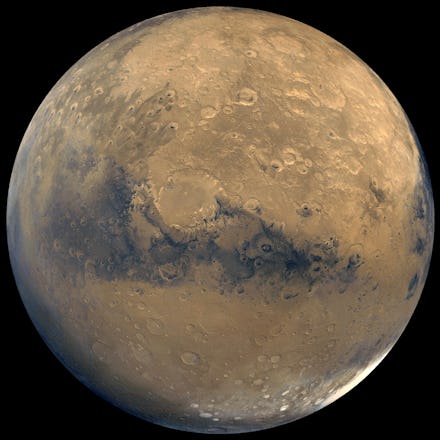NASA Just Took a Huge Step Toward Sending Humans to Mars

The news: NASA has completed a comprehensive review of the Space Launch System, the rocket system that could one day propel humans to Mars. What's more, they approved the project for development and committed about $7 billion in funding to make it a reality.
If all goes according to plan, NASA hopes to have the rocket ready for an unmanned three-day test mission -- which would send the craft past the moon and back for a soft landing in one of Earth's oceans -- by Nov. 2018. According to CBS, NASA engineers have estimated they have a 70% chance of hitting the target date.
NASA has thus passed the planning stages and is moving full-on ahead with the SLS project, which the agency projects will have an "unprecedented" lift capacity of 130 metric tons (143 tons).
"Our nation is embarked on an ambitious space exploration program, and we owe it to the American taxpayers to get it right," Associate Administrator Robert Lightfoot told media. "After rigorous review, we're committing today to a funding level and readiness date that will keep us on track to sending humans to Mars in the 2030s -- and we're going to stand behind that commitment."
What is the SLS? The SLS is composed of multiple stages, called "blocks."
ExtremeTech's Sebastian Anthony writes that the first stage, Block I, is composed of two Space Shuttle Solid Rocket Boosters (SSRBs) and a Space Shuttle External Tank combined with a cryogenic rocket. Block I is the device expected to be ready by 2018. Future variations will add more powerful engines, and by the 2030s Block II will replace the SSRBs with advanced boosters that will increase the total lift capacity to 155 metric tons (almost 171 tons). Block I alone will be the most powerful operating launch system on the planet when it debuts in just a few short years.
The SLS will carry an Orion Multi-Purpose Crew Vehicle, NASA's next-generation crew compartment designed to withstand an interplanetary journey (or one to an asteroid). It boasts a redesigned heat shielding component and will be able to carry 2-6 astronauts for an extended journey.
Why this is so important: NASA is taking the goal of landing humans on Mars by the 2030s seriously, and it's moving full-steam ahead on developing the technology necessary to make that trip a reality. "We are on a journey of scientific and human exploration that leads to Mars," NASA administrator Charles Bolden said in a statement. "And we're firmly committed to building the launch vehicle and other supporting systems that will take us on that journey."
If Americans are lucky, in just two decades we could have another triumph of space exploration even more impressive than the first moon landing in 1969 -- and make humanity a truly interplanetary species.